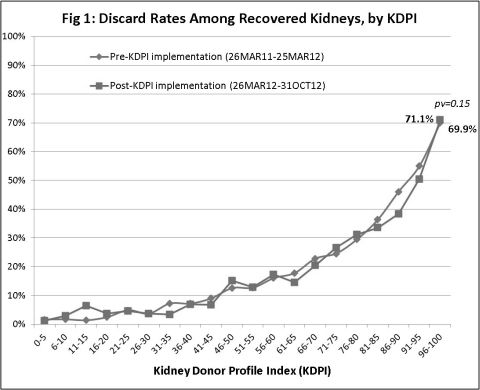Has Displaying KDPI in DonorNet® Led to a Spike in Discard Rates for Lower Quality Kidneys?
UNOS
Yale Med Ctr
Northwestern
Meeting: 2013 American Transplant Congress
Abstract number: 301
Background: The Kidney Donor Profile Index (KDPI), derived from the Kidney Donor Risk Index (KDRI), began appearing in DonorNet with kidney offers on March 26, 2012. Subsequently, anecdotal reports were received from OPOs, the UNOS Organ Center, and members of the OPTN Kidney Transplantation Committee (KTC) that merely displaying this new metric was making placement of lower quality kidneys extremely difficult. Liability concerns about being held liable for utilizing very high KDPI kidneys were thought to be driving up discard rates.
Methods: The KDPI was calculated for all kidney donors recovered in the 12 months prior to and 7 months after KDPI implementation. Kidney discard rates, as well as cold times and offer refusal rates for transplanted kidneys, were compared pre (Mar 26, 2011-Mar 25, 2012) vs. post implementation (Mar 26, 2012-Oct 31, 2012).
Results: Figure 1 shows that the discard rate for high KDPI kidneys remained virtually unchanged after displaying KDPI in DonorNet. Discard rates were very high for kidneys with KDPI≥96% both before (69.9%) and after (71.1%) implementation (p=0.15). The overall discard rate actually dropped slightly from 18.4% to 18.0%.

For transplanted kidneys with KDPI≥96%:
· Cold ischemic times did not increase from pre (N=193, mean=21.5 hours, median=18.7) to post (63, 20.0, 16.8) implementation.
· The number refusing centers did not increase: pre (mean=12.1, median=4.0), post (9.4, 4.0).
Conclusions: Displaying KDPI has not had the detrimental effects on kidney placement that were initially feared, at least at the national level. Still, efforts to decrease discard rates are needed, and some centers may have genuine concerns about transplanting high KDPI kidneys, even for patients expected to receive a net benefit over dialysis. A user-friendly, net-benefit calculator that would provide transplant programs empirical support for this decision may help counteract liability concerns; such a tool is under development by the SRTR by request of the KTC. Incorporating KDPI into a revised kidney allocation system is expected to help reduce offer refusals and discard rates through better matching of candidate and donor expected longevity.
To cite this abstract in AMA style:
Stewart D, Samana C, Cherikh W, Formica R, Friedewald J. Has Displaying KDPI in DonorNet® Led to a Spike in Discard Rates for Lower Quality Kidneys? [abstract]. Am J Transplant. 2013; 13 (suppl 5). https://atcmeetingabstracts.com/abstract/has-displaying-kdpi-in-donornet-led-to-a-spike-in-discard-rates-for-lower-quality-kidneys/. Accessed June 30, 2025.« Back to 2013 American Transplant Congress
